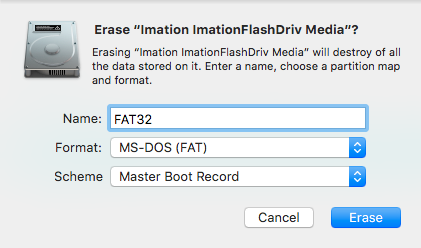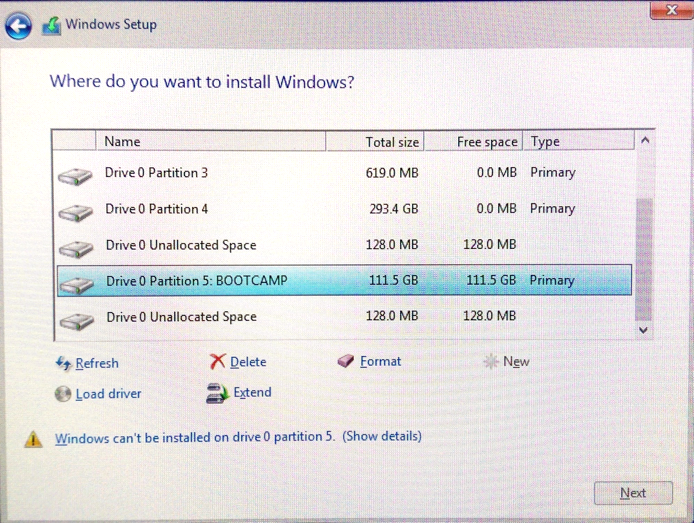Nov 10, 2017 I am seeing the same problem where FAT32 Thumb drives which have always worked on my Mac Pro now cannot be seen by Finder under 10.13.1. If I plug the thumb drive in, Finder never sees the drive. Yet if I go to Disk Utility, the drive is mounted properly, and First Aid does not report any issues on it. However, there is a little problem. To install Windows 10 on a UEFI system, you need to create a bootable drive with the FAT32 file system. The FAT32 file system can only store files that are less than 4GB. This may not be a problem for regular users. As of writing this, the Windows 10 default “install.wim” file is just barely under 4GB. The iCloud for Windows app and iCloud Drive gives users access to iCloud Drive files from within Windows 10 File Explorer and doesn't use up storage on the PC. IOS device, a Mac and on the.

| Click here to return to the 'Reading a FAT32 partition in OS X' hint |
 always been able to read and write FAT drives; 10.1 definitely could. That's why CompactFlash readers &c work.
always been able to read and write FAT drives; 10.1 definitely could. That's why CompactFlash readers &c work.(In fact, there's a minor problem with reading CompactFlash cards from EPOC machines such as Psions, but I have a workaround, and I believe this will be fixed in 10.3.)
Even in OS 9 I can see my NEO drive, when hooked to the right firewire enclosure, and that's also a FAT32 drive.
The extra directories that the mac writes are quite annoying in that setting, since they get written to the top of the drive, and clutter up your mp3 folders. I've been thinking about using terminal to delete them, next time I update the neo.
The neo is a really cool mp3 player for your car, btw, check it out at ssiamerica.com. The mac support is a little iffy, but you can make it work.

Since Mac 10.x is based on FreeBSD, it embraces the SMB protocols. If you were switching to a PC, you could use a crossover cable or a more proper network to just mount a Windows-formatted drive using
'Connect to Server'. Macs can read PC disks and so forth, but not vice versa; if you buy a PC-formatted Zip100 disk, you can use it back and forth between Mac and PC provided you delete the .trash files on it. You could also set up a VPN and run Windows boxes remotely. For more info, check out samba.org and google VPN.
One point made to me by my friends was that if you want an external
firewire/USB drive to be readable and writeable under MacOSX, Linux, and
Windows NT/2000/others, the firewire drive should be formatted as
FAT32. I don't believe any other filesystem format allows the
ability to read and write from all three operating systems.
One thing to note is that I wasn't able to format FAT32 partitions
of larger than ~30GB (at least under Windows 2000), so I had to
break an 80gB drive into 30gB/30gB/20gB sized partitions under Windows 2000
before I could format them. But once I partitioned the drive
and formatted the partitions, I could plug the drive
into my TiBook and see all the FAT32 partitions, and write to them.
You need to install the latest service packs for windows 2000 then you can very large hard drive partitions (greater than 30GB).
How To Split Up Windows 10 Ios For Fat32 On Mac Pc
This is simply not true. Windows 2000 and Windows XP won't let you format a drive using FAT 32 if it's larger than 30gigs because Microsoft wants you to use NTFS. If you format the drive using Windows 98 or even a Windows 2000/XP installation cd, your Windows 2000/XP will read the drive just fine. Microsoft decided to implement this arbitrary limit to try to get people to migrate to NTFS to make it harder for people to leave windows, and to mitigate problems with FAT32.
Suggestions for formatting a large FAT32 drive:
1) Use linux to format the drive.
2) Try Partition Magic or similar product, some of these have arbitrary limits as well, but usually larger than your average Windows OS.
3) Use Windows 98 with an updated service pack.
4) Use your Windows 2000/XP install cd and pretend to install Windows on the hard drive, it will ask you to format the drive and it will let you choose fat32 even for large devices.
Some interesting tips on using large firewire drives. DO NOT try to connect to a Mac OS 10.1 machine! For some odd reason my 100gig firewire drive cannot be understood by OS 10.1 but Jaguar (10.2) works just fine. At first I thought it was my drive, but it's a generic housing and putting smaller ~20gig drives in it works just fine.
Also trying to connect my titanium powerbook as an external firewire drive to a 10.1 desktop fails miserably (hold the T button down while booting your laptop to make it act as an external firewire device). But when I updated my desktops to Jaguar suddenly my laptop and my 100gig firewire drive worked just fine. I think there is a bug with large external firewire drives connecting to OS 10.1
Joseph Elwell.
Windows 10
Now, the thing is.. he was told that his 40 GB is a SCSI drive, and after some searching on apple's site and xlr8yourmac.com, I found that TDM doesn't support SCSI (yet). The real issue here is that when I opened his mac to look at the drive, it doesn't sat SCSI on it at all, and seems to use the built-in IDE and power cords that are part of the default G4.
It wouldn't be a problem if I didn't have both my IDE and power plug taken up by my two drives, both of which need to access his 40 GB...
Any help would be appreciated!
Thanks.
The limit for a FAT32 partition is 2 terabytes under Windows 9x OS's. The maximum size that can be used under Windows 2000 is 32 gigabytes (This is a limitiation of the file system driver for Windows 2000). Windows XP can only format a FAT32 partition up to 32 gigabytes at the time it is installed, but once up and running the maximum size it will format is 2 terabytes.
So if you want to interoperate with a 2k box, 32 gigabytes is the limit.
The maximum size for a single file on a FAT32 partition is 4 gigabytes.
NTFS has a maximum partition size and file size of 16 exabytes.
How To Split Up Windows 10 Ios For Fat32 On Mac Computer
In PANTHER how do you mount the disk for write enable??
Thank you
Disk Utility User Guide
In Disk Utility, you can format an external disk that you can use with both a Microsoft Windows–based computer and a Mac. For example, you might want to do this if you use a flash drive to store data files you need to use on your Mac at home and when using a Windows-based computer at school or your local library.
WARNING: Formatting a disk or volume erases all the files on it. Save any files you need to another volume before formatting.
In the Disk Utility app on your Mac, choose View > Show All Devices.
If Disk Utility isn’t open, click the Launchpad icon in the Dock, type Disk Utility in the Search field, then click the Disk Utility icon .
In the sidebar, select the disk you want to format to use with Windows computers.
Click the Erase button in the toolbar.
In the Erase dialogue, click the Scheme pop-up menu, then choose a partition scheme.
Click the Format pop-up menu, then choose one of the following:
MS-DOS (FAT): Choose this format if the size of the disk is 32GB or less.
ExFAT: Choose this format if the size of the disk is over 32GB.
Enter a name for the volume.
The maximum length for the volume name is 11 characters.
Click Erase, then click Done.
How To Split Up Windows 10 Ios For Fat32 On Mac Hard Drive


